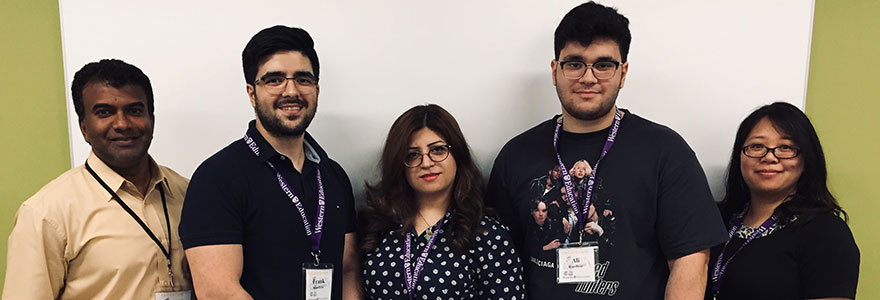
Professor Anton Puvirajah, left, Frank Kooshyar, Mina Sedaghatjou, Ali Kooshyar and Olisa Wong worked with students at the coding and robotics STEM camp held at the Faculty of Education (not in photo: Christian Landry).

Professor Anton Puvirajah, left, Frank Kooshyar, Mina Sedaghatjou, Ali Kooshyar and Olisa Wong worked with students at the coding and robotics STEM camp held at the Faculty of Education (not in photo: Christian Landry).
Immigrant students are underrepresented in science, technology, engineering and mathematics (STEM) when compared to their Canadian-born peers and one researcher from the Faculty of Education wants to change this outcome.
Professor Anton Puvirajah created a coding and robotics STEM camp for newly-arrived immigrant students.
It’s a fun-way for students to learn STEM while at the same time it’s an important research tool for Puvirajah and his team to understand why immigrant-students aren’t sufficiently represented in these fields.
“They kind of fall through the cracks during the first couple of years of school and it’s very difficult for them to get caught up,” said Puvirajah. “We wanted to go about mitigating some of the factors that affect their STEM performance and their STEM engagement.”
Fifteen students between 10 to 13 years of age participated in the camp. They’ve been in Canada between four months to four years.
The camp has been popular. Spaces were filled in three days.
Students learned computational thinking – a problem-solving approach that uses logic to understand information while developing solutions using algorithmic design, said Puvirajah.
Specifically, students learned how to recognize patterns, break down big problems into smaller, easier-to-manage problems, leaned how to remove parts of the problem that aren’t necessary and make one solution work for a number of problems. Finally, they created step-by-step instructions on how to do something, said Puvirajah.
Students were in camp for a half-a-day over eight days. They learned using:
One of the research goals was to look into factors that play a role in newly-arrived immigrant students’ engagement with STEM. The researchers asked students about their learning experiences at the camp as well as in Canada and from their previous home countries.
“We also want to find out the types of culturally responsive and sustaining teaching practices that engage students in STEM and more specifically in computational thinking,” said Puvirajah.
While not everyone will have a STEM career, Puvirajah said he wants students to appreciate the beauty of science and see its relevance to their everyday lives. What’s more, he feels it’s important students reach their full potential.
“When we have the resources, why do we want to leave children behind?”